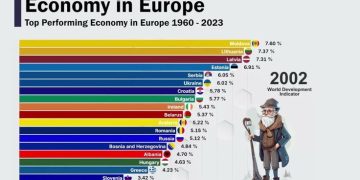Monetary Policy Divergence in East Asia: Japan, South Korea, and the Future of Regional Capital Flows
Introduction: A Tale of Two Approaches
East Asia’s economies are at a pivotal moment. Japan and South Korea—two highly industrialized economies with advanced financial systems—are navigating dramatically different monetary environments. These divergences have profound implications for interest rates, currency stability, inflation, cross-border capital flows, and investor behavior across the region.
The COVID-19 pandemic, supply chain disruptions, geopolitical tensions, and rising global inflation have forced central banks to adopt strategies suited to their domestic economic realities. Japan continues to pursue ultra-loose monetary policy, emphasizing debt sustainability and economic stimulus. South Korea, in contrast, is tightening monetary conditions to combat inflation and maintain currency stability.
This divergence highlights the complexities of regional financial coordination and the risks and opportunities for investors, multinational corporations, and emerging markets in East Asia.
1. Japan: The Persistence of Ultra-Loose Monetary Policy
1.1 Historical Context
Japan has operated near-zero or negative interest rates for over two decades, reflecting:
- prolonged economic stagnation since the 1990s
- deflationary pressures
- high public debt (~260% of GDP)
The Bank of Japan (BoJ) has implemented aggressive tools:
- Quantitative Easing (QE)
- Yield Curve Control (YCC)
- Asset purchase programs
- Forward guidance on ultra-low rates
Even post-pandemic, BoJ has maintained its accommodative stance despite global tightening.
1.2 Inflation Dynamics
Japan’s inflation remains below the BoJ’s 2% target for much of the past decade. Recent spikes in energy and commodity prices created only modest inflationary pressure, due to:
- low domestic consumption
- strong currency control mechanisms
- labor market rigidity
Japan demonstrates a unique environment where ultra-loose policy continues in the face of rising global rates.
1.3 Currency Implications
The Japanese yen has weakened against the dollar, especially as the US and South Korea tighten policy. This has consequences:
- exporters benefit (automobiles, electronics)
- import costs rise, increasing energy and raw material prices
- cross-border investment becomes more attractive due to low yields domestically
BoJ’s insistence on maintaining negative rates contrasts sharply with its neighbors.
2. South Korea: Inflation Control and Monetary Tightening
2.1 Pandemic and Post-Pandemic Response
The Bank of Korea (BOK) initially adopted ultra-low rates during the pandemic, but inflationary pressures—driven by:
- energy costs
- supply chain bottlenecks
- global demand recovery
prompted a shift to a tightening cycle in 2022–2025.
2.2 Current Policy Tools
South Korea employs a mix of conventional and unconventional tools:
- raising policy rates (currently above 3%)
- FX interventions to stabilize the won
- macroprudential policies to cool real estate and household debt
- forward guidance to manage market expectations
The BOK faces the dual challenge of controlling inflation without stifling growth.
2.3 Currency and Capital Flow Dynamics
The Korean won has appreciated relative to other emerging markets but remains vulnerable to:
- US Fed rate policy
- capital flight due to global risk-off sentiment
- regional currency volatility
Investors are increasingly navigating yield differentials between Korea, Japan, and the US, influencing bond flows and equity positioning.
3. Divergence in Policy: Causes and Consequences
3.1 Demographics and Growth Expectations
- Japan: aging population, low productivity growth, deflationary mindset
- South Korea: relatively younger population, stronger tech-driven growth, inflationary pressures
These factors justify divergent monetary strategies.
3.2 Fiscal Policy Constraints
- Japan: extremely high public debt limits the BoJ’s flexibility to tighten
- South Korea: moderate debt, room for conventional rate hikes
Fiscal realities shape central bank policy choices.
3.3 Global Capital Flow Implications
Divergent monetary strategies create arbitrage opportunities:
- Japanese investors seek higher-yielding assets abroad
- Korean assets attract carry trades, increasing volatility
- FX hedging and currency swaps become critical for multinational corporations
Capital flows increasingly follow the path of policy rate differentials and perceived risk-adjusted returns.
4. Regional Spillovers
4.1 Emerging Markets in Asia
East Asia’s policy divergence affects neighboring economies:
- Emerging markets must adjust FX reserves in response to yen depreciation and won appreciation
- Capital inflows/outflows can cause sudden liquidity swings
- Trade competitiveness shifts based on currency movements
4.2 Export-Oriented Industries
- Japanese exporters benefit from a weak yen
- South Korean tech firms face higher input costs due to currency strength
- Global supply chains are impacted, influencing pricing and investment decisions
4.3 Financial Market Volatility
- Regional bond spreads widen due to interest rate differentials
- Equity markets respond to both domestic monetary signals and cross-border capital flows
- Emerging market currencies may experience sudden swings as investors seek relative yield and stability

5. The Role of FX Intervention and Reserve Management
Both countries actively manage currency risk:
Japan
- Historically uses FX interventions sparingly
- Relies on market mechanisms and BoJ’s forward guidance
- Weak yen promotes export competitiveness but raises import costs
South Korea
- More active in FX market to stabilize won
- Holds sizable foreign exchange reserves (~USD 450B)
- Adjusts macroprudential measures to prevent capital outflows
FX strategy is a critical tool complementing monetary policy.
6. Inflation and the Cost of Divergence
6.1 Japan’s Low Inflation Environment
Japan can maintain ultra-low rates due to:
- persistent deflationary pressures
- moderate domestic consumption
- high public debt requiring low financing costs
6.2 South Korea’s Inflation Concerns
South Korea must:
- contain headline inflation (energy, food, housing)
- prevent long-term inflation expectations from rising
- balance economic growth with price stability
6.3 Regional Inflation Spillovers
Policy divergence creates differential inflation impacts:
- Import costs from Japan rise for South Korea and neighboring economies
- Regional pricing dynamics shift based on currency adjustments
- Trade competitiveness is constantly recalibrated
7. Cross-Border Financial Integration and Policy Coordination
Despite divergence, East Asia remains economically integrated:
- Supply chains across Japan, Korea, China, and ASEAN
- Regional trade agreements (RCEP)
- Financial cooperation forums (Asian Bond Markets Initiative, AMRO)
Policy coordination remains complex due to:
- differing domestic priorities
- global monetary pressures (Fed, ECB, BoJ)
- currency volatility and capital flow management
8. Implications for Investors and Corporates
8.1 Fixed Income Investors
- Japanese government bonds yield near-zero—investors seek Korea, US, or emerging market debt
- Interest rate arbitrage opportunities arise due to policy divergence
8.2 Equity Markets
- Exporters benefit from yen weakness
- Tech-heavy Korean equities may face input cost pressure
- Regional supply chains’ cost structures shift dynamically
8.3 FX and Hedging Strategies
- Currency risk management is essential
- Corporates increasingly use derivatives to hedge against policy divergence
9. Challenges and Risks
9.1 Geopolitical Risk
- US-China tensions
- Regional trade disputes
- Potential capital controls
9.2 Policy Mistakes
- Japan tightening prematurely could destabilize bond markets
- Korea over-tightening could slow growth and reduce competitiveness
9.3 Global Monetary Spillovers
- Fed and ECB policies influence local bond yields and FX movements
- Emerging markets face amplified volatility
10. The Road Ahead: Regional Policy Outlook
- Japan is likely to maintain ultra-loose policy until sustainable inflation rises
- South Korea will gradually normalize rates while monitoring currency strength
- Regional spillovers will continue, especially for ASEAN economies and emerging Asia
- Investors must navigate a complex landscape of currency, interest rates, and cross-border capital flows
East Asia represents a microcosm of how monetary policy divergence affects trade, investment, and regional stability in a post-pandemic, globally connected economy.
Conclusion: Divergence as a Strategic Choice
Japan and South Korea exemplify the nuanced tailoring of monetary policy to domestic conditions:
- Japan prioritizes debt sustainability and economic stimulus
- South Korea emphasizes inflation control and currency stability
This divergence demonstrates that one-size-fits-all policies are ineffective in interconnected but heterogeneous regional economies. Capital flows, FX volatility, trade competitiveness, and investor strategy must now account for these differences.
East Asia’s monetary landscape will remain dynamic, reflecting the interplay between domestic priorities, regional integration, and global economic pressures. For multinational corporations, investors, and policymakers, understanding this divergence is key to navigating the 2020s financial landscape in Asia.
































